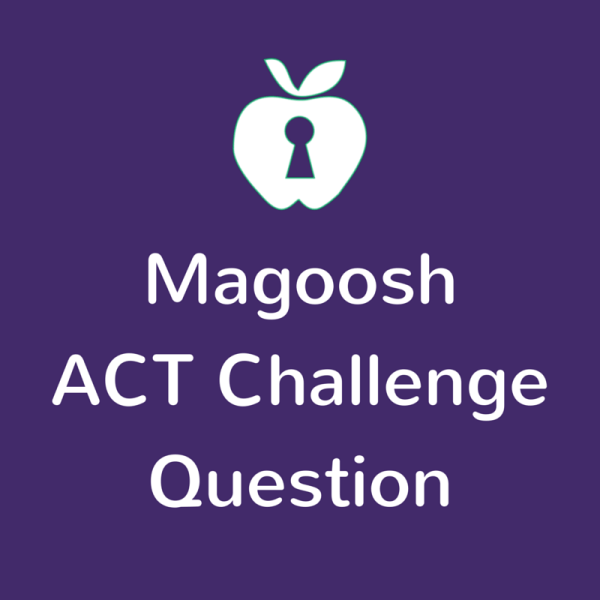
If you ask most test-takers what they find hardest about ACT Science, you’ll get a lot of answers that boil down to the complex scientific jargon thrown around in the passages. Yes, the ACT Science test does use a lot of specific terms, but know that you can master these by test day. That way, when you’re confronted by the most challenging problems, you’ll be able to read between the lines of all that jargon and reason your way to the correct answer, even on hard ACT Science problems.
The “secret” to this process is that it does take practice. Never fear: we’ve put together four ACT challenge problems for Science below. Take your best shot, then check out the answers and explanations that follow to hone your skills even more!
Want to make sure you’ve mastered the trickiest concepts in all areas? For hard ACT problems from other ACT sections, check out:
PASSAGE 1 (CONFLICTING VIEWPOINTS):
Deoxyribonucleic acid, or DNA, is the molecule within living organisms that encodes the genetic code that informs an organism’s development and functioning. This molecule consists of two long strands, each of which is made up of subunits called nucleotides. These two strands wind around one another, forming the characteristic double helix shape of DNA.
There are four nucleotides used in the production of DNA–guanine, adenine, cytosine, and thymine–that are often referred to as G, A, C, and T, respectively.
Nucleotides pair up in a predictable way as illustrated in the figure: for every “G” on the first strand, there is a “C” on the opposite strand, and for every “A” on the first strand, there is a “T” on the opposite strand. A set of two paired nucleotides is typically referred to as a base pair, and the nucleotides within each pair are held together with hydrogen bonds. Because of the consistency of these pairings, the two individual paired strands can be said to be complementary: the sequence of nucleotides on one strand can be entirely determined if the sequence of bases on the opposite strand is known.

During the process of DNA replication, two identical DNA molecules are produced from a single original piece of DNA through the action of an enzyme known as DNA polymerase. Shortly after DNA’s structure was determined by James Watson and Francis Crick, there was substantial debate in the scientific community regarding how this process occurs. Two of the prevailing viewpoints in this discussion are given below.
Scientist A
When DNA is not in the process of being replicated, it is found tightly coiled and bound to proteins. Prior to replication, the coiling is loosened and some of the proteins are removed, allowing the two strands of the DNA molecule to be separated. DNA polymerase then acts on each of these individual strands separately, adding new nucleotides by matching them to complementary nucleotides on the original strand. Proteins bind to both new DNA molecules following the completion of replication, facilitating the re-coiling of the DNA.
Scientist B
It is known that intact DNA is typically found bound to proteins known as histones. During DNA replication, the histones remain attached to the DNA molecule, but serve to slightly alter the shape of the double helix, allowing DNA polymerase to access and “read” the base pairs while leaving the overall structure intact. DNA polymerase slides along the length of the DNA-histone molecular complex, producing an entirely new double-stranded DNA molecule bound to new histones as it is synthesized.
Passage 1 Questions
1. Based on the description of DNA given in the passage, which of the following could be the nucleotide composition of a DNA double helix?
A. 20% adenine, 20% guanine, 30% thymine, 30% cytosine
B. 60% adenine, 20% thymine, 10% guanine, 10% cytosine
C. 20% adenine, 20% thymine, 30% guanine, 30% cytosine
D. 60% adenine, 20% guanine, 10% thymine, 10% cytosine
2. Consider the following diagrams showing possible mechanisms of DNA replication. Which of the following best describes how the diagrams relate to the hypotheses of Scientists A and B?



A. Scientist A = Model 1, Scientist B = Model 2
B. Scientist A = Model 2, Scientist B = Model 1
C. Scientist A = Model 3, Scientist B = Model 2
D. Scientist A = Model 2, Scientist B = Model 3
PASSAGE 2: RESEARCH SUMMARIES
In a simple DC electrical circuit, a battery provides a change in voltage (V) that induces an electric current (I) through the circuit. A conductor placed in the circuit is characterized by its resistance (R) to this flow of electric charge. The relationship between voltage, current, and resistance is known as Ohm’s Law, which is represented by the following formula:
V = I × R
A student performed a series of experiments with a simple circuit to test Ohm’s law. Measurements of current were taken using an ammeter. The circuit diagram is presented in Figure 1.
Figure 1
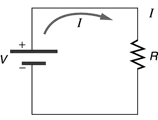
Experiment 1
The student set up a simple circuit consisting of a battery and a single resistor. The resistor was taken from an electronics kit and wired into the circuit. Using an ammeter, the student measured current in the circuit for batteries of three different voltages and recorded the results in Table 1.
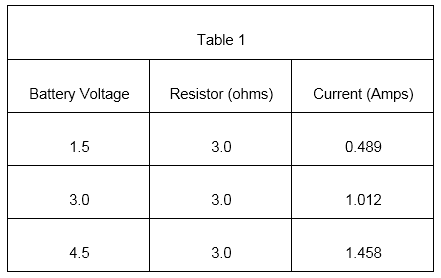
Experiment 2
Using the same circuit as in the previous experiment, the student tried three different resistors. The current flowing through the circuit with each resistor was measured with an ammeter, and recorded in Table 2.
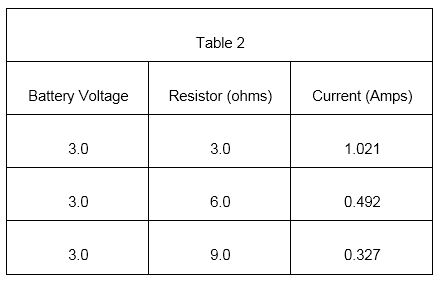
Experiment 3
To test the electrical resistance of some common battery-operated appliances, the student set up a simple circuit consisting of a 15.0-volt battery and a socket to plug in the appliance. The current was measured using an ammeter and recorded in Table 3.
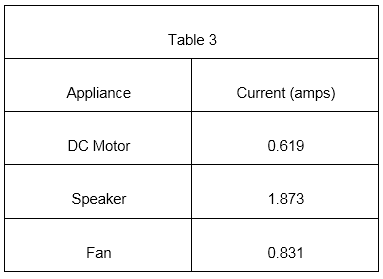
Passage 2 Questions
3. Does the information provided in the passage and Table 1 support the conclusion that as voltage increases in a circuit, current always increases?
A. Yes, circuits with the highest voltage always produced the highest current.
B. Yes, circuits with the lowest resistance always produced the highest current.
C. No, circuits with highest resistance produced the lowest current.
D. No, circuits with the highest voltage produced the highest current only when the resistance was held constant.
4. The total resistance in a circuit for resistors connected in series is the sum of their individual resistances. Suppose the student rewired the circuit with a 3.0 ohm and a 6.0 ohm resistor in series, using a 3.0 V battery to supply the voltage. What current would an ammeter placed in this circuit most likely read?
A. 0.333 amps
B. 0.667 amps
C. 1.333 amps
D. 1.500 amps
Answers and Explanations
1. ANSWER: C, 20% adenine, 20% thymine, 30% guanine, 30% cytosine
The passage tells us that for every A on one strand, there is a T on the opposite strand, while for every G, there is a C. Therefore, any given molecule of double-stranded DNA must have equal amounts of A and T nucleotides and equal amounts of G and C nucleotides. This is true whether we are talking about specific numbers or percentages. The only answer choice that fits this criteria is C.
2. ANSWER: A, Scientist A = Model 1, Scientist B = Model 2
Scientist A describes the two original strands as splitting apart, with each one being incorporated into a new DNA double helix, which fits the diagram in Model 1. Scientist B describes the original DNA molecule staying intact, and an entirely new one being formed, which fits the diagram in Model 2. Model 3 is a different model entirely from the ones described in the passage: in this third model, the original double helix is broken into segments that act as templates for the creation of new DNA molecules.
3. ANSWER: D, No, circuits with the highest voltage produced the highest current only when the resistance was held constant.
Don’t be fooled by answer choice A! Referring to Table 1, we find the relationship described by the question stem. Notice that the resistance is held constant throughout. Only answer choice D correctly describes the situation—current only increases if the resistance is held constant. In other words, if a much higher resistance value were used in a circuit with a higher voltage battery, we couldn’t necessarily conclude that the current would be higher without knowing that the resistance was held constant in our comparison. You can also figure this out by looking at the equation for Ohm’s law: V = I x R. If the resistance is held constant then we can see there is a directly proportional relationship between voltage and current. But if the resistance were to change it would affect the entire equation.
4. ANSWER: A, 0.333 amps
Applying the definition in the question, we can see that the resistance for a circuit with a total resistance of 3.0 + 6.0 = 9.0 ohms will be the same as it is for a 9.0 ohm resistor alone. Going back to Table 2, we can look up this value as 0.327 amps. Answer choice A is closest to this number. Alternately, you could calculate the current using the formula provided to come up with the exact value. Note that answer choice C is a trap for students who make a bad assumption by simply adding up the measured currents listed in the table for resistors of 3.0 and 6.0 amps.



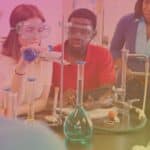


Leave a Reply